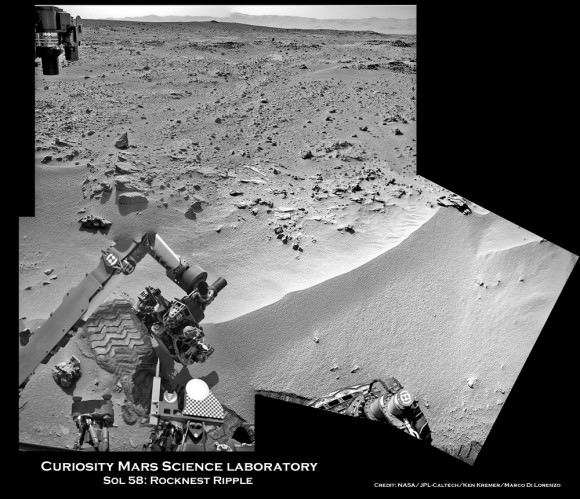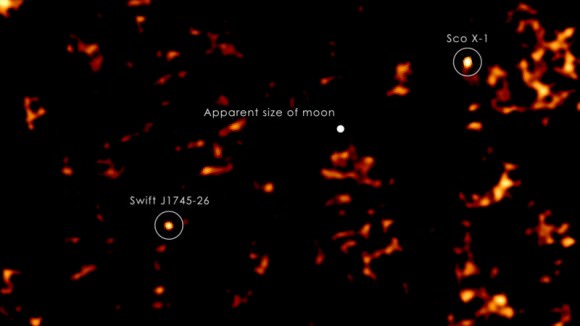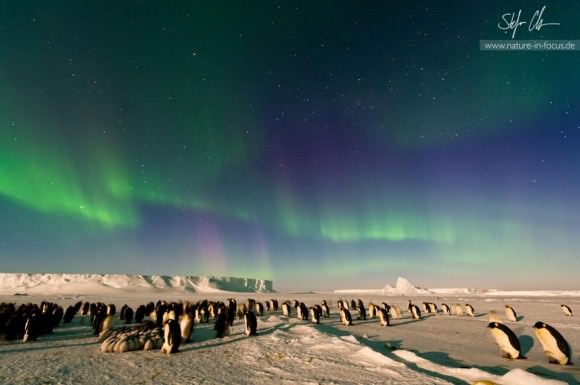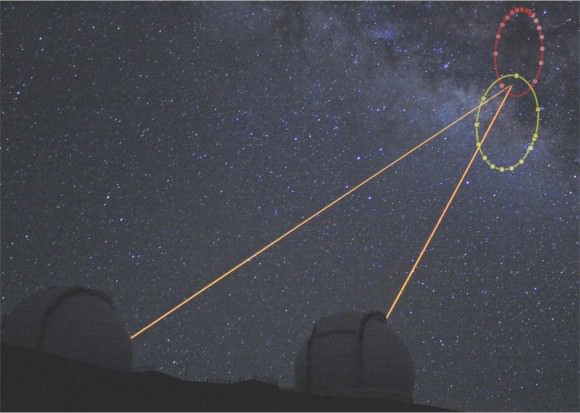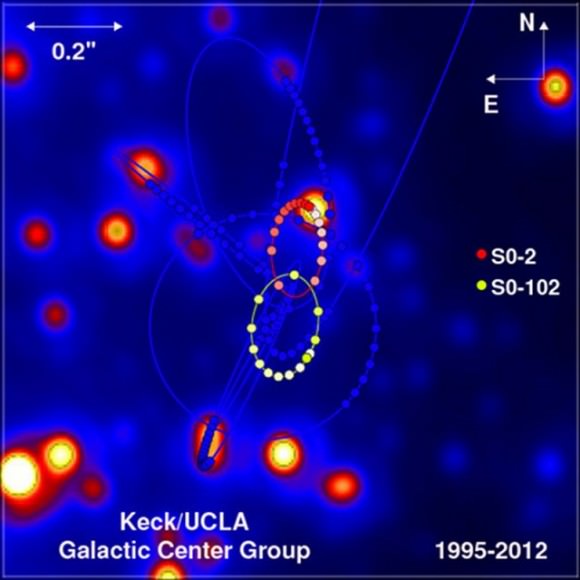Curiosity Set for 1st Martian Scooping at ‘Rocknest’ Ripple
Image caption: Context view of Curiosity working at ‘Rocknest’ Ripple. Curiosity’s maneuvers robotic arm for close- up examination of ‘Rocknest’ ripple site and inspects sandy material at “bootlike” wheel scuff mark with the APXS (Alpha Particle X-Ray Spectrometer) and MAHLI (Mars Hand Lens Imager) instruments positioned on the rotatable turret at the arm’s terminus. Mosaic was stitched together from Sol 57 & 58 Navcam raw images and shows the arm extended to fine grained sand ripple in context with the surrounding terrain and eroded rim of Gale Crater rim on the horizon. Rocknest patch measures about 8 feet by 16 feet (2.5 meters by 5 meters).See NASA JPL scooping video below. Credit: NASA/JPL-Caltech/Ken Kremer/Marco Di Lorenzo
NASA’s Curiosity rover is set to scoop up her 1st sample of Martian soil this weekend at a soil patch nicknamed ‘Rocknest’. This marks a major milestone on the path to delivering Mars material to the sample acquisition and processing system for high powered analysis by the robots chemistry labs and looking for the ingredients of life, said the science and engineering team leading the mission at a media briefing on Thursday, Oct 4.
Since landing on the Red Planet two months ago on Aug. 5/6, Curiosity has trekked over 500 yards eastwards across Gale crater towards an intriguing area named “Glenelg” where three different types of geologic terrain intersect.
This week on Oct. 2 (Sol 56), the rover finally found a wind driven patch of dunes at ‘Rocknest’ with exactly the type of fine grained sand that the team was looking for and that’s best suited as the first soil to scoop and injest into the sample acquisition system.
Read more: http://www.universetoday.com/97720/curiosity-set-for-1st-martian-scooping-at-rocknest-ripple/#ixzz28WfhHyod
Rare X-Ray Nova Reveals a New Black Hole in the Milky Way
Swift J1745-26, with a scale of the moon as it would appear in the field of view from Earth. This image is from September 18, 2012 when the source peaked in hard X-rays. Credit: NASA/Goddard Space Flight Center/S. Immler and H. Krimm
Back in mid-September, the Swift satellite was going about its multi-wavelength business of watching for bursts of bright gamma-ray, X-ray, ultraviolet, or optical events in the sky, when it detected a rising tide of high-energy X-rays from a source toward the center of our Milky Way galaxy. But this was different from any other burst the satellite had detected, and after observing the event for a few days, astronomers knew this had to be a rare X-ray nova. What it meant was that Swift had detected the presence of a previously unknown stellar-mass black hole.
“Bright X-ray novae are so rare that they’re essentially once-a-mission events and this is the first one Swift has seen,” said Neil Gehrels from Goddard Space Flight Center, the mission’s principal investigator. “This is really something we’ve been waiting for.”
The object was named Swift J1745-26 after the coordinates of its sky position, the nova is located a few degrees from the center of our galaxy toward the constellation Sagittarius. While astronomers do not know its precise distance, they think the object resides about 20,000 to 30,000 light-years away in the galaxy’s inner region.
An X-ray nova is a short-lived X-ray source that appears suddenly in the sky and dramatically increases in strength over a period of a few days and then decreases, fading out over a few months. Unlike a conventional nova, where the compact component is a white dwarf, an X-ray nova is caused by material – usually gas — falling onto a neutron star or a black hole.
The rapidly brightening source triggered Swift’s Burst Alert Telescope twice on the morning of Sept. 16, and once again the next day.
Ground-based observatories detected infrared and radio emissions, but thick clouds of obscuring dust have prevented astronomers from catching Swift J1745-26 in visible light.
The nova peaked in hard X-rays — energies above 10,000 electron volts, or several thousand times that of visible light — on Sept. 18, when it reached an intensity equivalent to that of the famous Crab Nebula, a supernova remnant that serves as a calibration target for high-energy observatories and is considered one of the brightest sources beyond the solar system at these energies.
Even as it dimmed at higher energies, the nova brightened in the lower-energy, or softer, emissions detected by Swift’s X-ray Telescope, a behavior typical of X-ray novae. By Wednesday, Swift J1745-26 was 30 times brighter in soft X-rays than when it was discovered and it continued to brighten.
“The pattern we’re seeing is observed in X-ray novae where the central object is a black hole. Once the X-rays fade away, we hope to measure its mass and confirm its black hole status,” said Boris Sbarufatti, an astrophysicist at Brera Observatory in Milan, Italy, who currently is working with other Swift team members at Penn State in University Park, Pa.
Here’s usually happens in events like this: The black hole is part of a binary system with a normal Sun-like star. A stream of material flows into an accretion disk around the black hole. Usually, the disk of gas spirals in steadily to the black hole, heats up and produces a steady X-ray glow. But sometimes, for reasons unknown, the material is held up in the outer regions, held back by some mechanism, almost like a dam. Once enough gas accumulates, the dam breaks and a flood of gas surges towards the black hole, creating the X-ray nova outburst.
“Each outburst clears out the inner disk, and with little or no matter falling toward the black hole, the system ceases to be a bright source of X-rays,” said John Cannizzo, a Goddard astrophysicist. “Decades later, after enough gas has accumulated in the outer disk, it switches again to its hot state and sends a deluge of gas toward the black hole, resulting in a new X-ray outburst.”
This phenomenon, called the thermal-viscous limit cycle, helps astronomers explain transient outbursts across a wide range of systems, from protoplanetary disks around young stars, to dwarf novae — where the central object is a white dwarf star — and even bright emission from supermassive black holes in the hearts of distant galaxies.
It is estimated that our galaxy must harbor some 100 million stellar-mass black holes. Most of these are invisible to us, and only about a dozen have been identified.
Swift discovers about 100 bursts per year. The Burst Alert Telescope detects GRBs and other events and accurately determines their positions on the sky. Swift then relays a 3 arcminute position estimate to the ground within 20 seconds of the initial detection, enabling ground-based observatories and other space observatories the chance to observe the event as well. The Swift spacecraft itself “swiftly” –in less than approximately 90 seconds — and autonomously repoints itself to bring the burst location within the field of view of the sensitive narrow-field X-ray and UV/optical telescopes to observe the afterglow and gather data.
Video: 55 Years of Space Exploration
Yesterday marked the 55th anniversary of the Sputnik launch, which sent the first artificial satellite into orbit. It was actually a fairly small satellite, about the size of a basketball, but it had a big impact. It set in motion not only the space race, but jump-started a push for education and technology development. Thanks to the giant leap of Sputnik, we now use satellites for telecommunications, weather prediction, remote sensing, and navigation, not to mention the exploration of space.
Once in a Lifetime Image: Emperor Penguins Under the Aurora Australis
Emperor Penguins on the Antarctic Sea Ice Under the Aurora Australis. Credit and copyright: Stefan Christmann. Used by permission.
Photographer Stefan Christmann called this incredible Antarctic view a once in a lifetime experience.
“It was the most impressive experience to sit on the sea-ice and watch the Aurora Australis dance above the penguin colony with the sounds of the chicks and the adult penguins. I feel truly blessed for having had the opportunity to witness this once in a lifetime experience,” he told Universe Today.
Christmann is currently based in Antarctica, working at the German Antarctic research station Neumayer III. He is an “overwinterer” — scientific and technical staff who stay at the base for the entire southern winter — and will stay in Antarctica for an uninterrupted 14 months. “As a physicist, my duty is to maintain the data acquisition of our seismological and geomagnetic observatories as well as the analysis of the collected data,” Christmann said.
Christmann is currently based in Antarctica, working at the German Antarctic research station Neumayer III. He is an “overwinterer” — scientific and technical staff who stay at the base for the entire southern winter — and will stay in Antarctica for an uninterrupted 14 months. “As a physicist, my duty is to maintain the data acquisition of our seismological and geomagnetic observatories as well as the analysis of the collected data,” Christmann said.
But he is also an accomplished photographer. His website and Facebook page are filled with beautiful nature images from around the world, and recently feature the Emperor penguins and their adorable chicks, as well as the stark beauty of the Antarctic landscape.
Originally from Germany, he studied photography in the US, and his work has now brought him to an extended stay in Antarctica.
Christmann explained the conditions and the difficulties in obtaining this shot, one he had long hoped for, the planning of it always in the back of his mind.
“The picture was taken at Atka-Bay on the sea-ice. The bay is roughly 8 km away from our station so the penguin colony is a popular destination for free-time trips. The idea of a photo of the Aurora Australis above the penguin colony had been in my head for a long time, but the conditions have to be just right –which usually never happens. You need a full Moon, high magnetic activity and a cloudless sky. Also the penguins should be standing close enough to the ice-berg. I made multiple attempts to get the photo, but we either had incoming clouds, low activity or had to cancel our stay because of wind picking up (which can be really dangerous out on the sea-ice).”
And time was short, as after he had been outside for a few hours the wind picked up and he and his accomplices had to leave the ice for safety reasons. “Otherwise we probably would have sat there all night!” Christmann said. The image was taken on October 1, 2012.
Christmann shared what equipment he uses as well as a few tips for Antarctic and cold weather photography.
“I used a Nikon D700 Fullframe DSLR with an AF-S G-Nikkor 14-24mm f/2.8. ISO settings varied with the intensity of the aurora from ISO 500-800,” he said. “F-Stops in the range of 4.0-5.6 and Exposure times from 20s to 30s. I try to keep ISO as low as possible for noise reasons and also try to limit the exposure time in order not to get star trails. It’s either super long star trails or almost star-dots, but I don’t really like the in between. A full battery charge (in my case around 2500mAh) lasts around 1h in the cold, so I had to switch batteries twice during our stay out on the ice!”
Asked what other details he felt was important to share about this image, Christmann said, “Antarctica is an incredible place where nature dwarfs anything made by humans. Hopefully people will gain even more interest in this continent and help to protect it as well as its inhabitants.”
Two Stars Do a Short-Orbit Tango Around the Milky Way’s Black Hole
Astronomers have known for some time there was one star orbiting fairly close to the black hole at the center of our galaxy. But now another star has been found dipping close and orbiting even faster around the Milky Way’s central black hole. Astronomer Andrea Ghez from UCLA says the ability to watch these two stars in a short-period ‘tango’ around the black hole will help scientist measure the effects of space-time curvature, and they should be able to determine whether Albert Einstein was right in his prediction of how black holes could warp space and time.
Read more: http://www.universetoday.com/97715/two-stars-do-a-short-orbit-tango-around-the-milky-ways-black-hole/#ixzz28WNuqRD7
“I’m extremely pleased to find two stars that orbit our galaxy’s supermassive black hole in much less than a human lifetime,” said Ghez. “It is the tango of [these stars] that will reveal the true geometry of space and time near a black hole for the first time. This measurement cannot be done with one star alone.”
There are nearly 3,000 stars that orbit somewhat close to the black hole, and most of them have orbits of 60 years or longer.
The previously known close-in star, S0-2, orbits the black hole every 15.5 years. And now, the newly found star, called S0-102, orbits the black hole in a blazing 11.5 years, the shortest known orbit of any star near this black hole.
There are nearly 3,000 stars that orbit somewhat close to the black hole, and most of them have orbits of 60 years or longer.
The previously known close-in star, S0-2, orbits the black hole every 15.5 years. And now, the newly found star, called S0-102, orbits the black hole in a blazing 11.5 years, the shortest known orbit of any star near this black hole.
Reconstruction of the orbits of two stars—S0-2 and S0-102—near the black hole at the Milky Way’s center. (Other stars’ orbits are also depicted by fainter lines.) The background is a real high-resolution infrared image of the region. Credit: Andrea Ghez et al./UCLA/Keck
In the same way that planets orbit around the sun, S0-102 and S0-2 are each in an elliptical orbit around the central black hole. Ghez said that the planetary motion in our solar system was the ultimate test for Newton’s gravitational theory 300 years ago, and now the motion of S0-102 and S0-2 will be the ultimate test for Einstein’s theory of general relativity, which describes gravity as a consequence of the curvature of space and time.
“The exciting thing about seeing stars go through their complete orbit is not only that you can prove that a black hole exists but you have the first opportunity to test fundamental physics using the motions of these stars,” Ghez said. “Showing that it goes around in an ellipse provides the mass of the supermassive black hole, but if we can improve the precision of the measurements, we can see deviations from a perfect ellipse — which is the signature of general relativity.”
As the stars come to their closest approach, their motion will be affected by the curvature of spacetime, and the light traveling from the stars to us will be distorted, Ghez said.
S0-2, which is 15 times brighter than S0-102, will go through its closest approach to the black hole in 2018. S0-102 makes its closest approach in 2021, so the team will be keeping an eye on these stars as they get tantalizingly close, but not close enough to get sucked in, Ghez said.
Ghez and her colleagues have been observing S0-2 since 1995. In 2000, she and her team reported — for the first time – that astronomers had seen stars accelerate around the supermassive black hole. Their research demonstrated that three stars had accelerated by more than 250,000 mph a year as they orbited the black hole. The speed of S0-102 and S0-2 should also accelerate by more than 250,000 mph at their closest approach, Ghez said.
“The fact that we can find stars that are so close to the black hole is phenomenal,” said Ghez. “Now it’s a whole new ballgame, in terms of the kinds of experiments we can do to understand how black holes grow over time, the role supermassive black holes play in the center of galaxies, and whether Einstein’s theory of general relativity is valid near a black hole, where this theory has never been tested before. It’s exciting to now have a means to open up this window.”
Read more: http://www.universetoday.com/97715/two-stars-do-a-short-orbit-tango-around-the-milky-ways-black-hole/#ixzz28WNVbPNi
